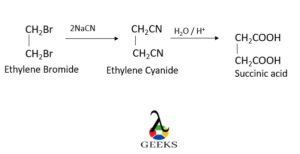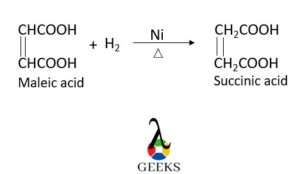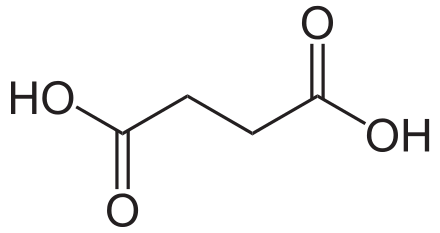In this article we will discuses on the 3 facts on C4H6O4 + O2 : what how to balance.
The succinic acid or C4H6O4 is a white shiny odorless crystal with a has a molar mass of 118.09 g/mol, and O2 is the dioxygen that reacts with each other to form carbon dioxide (CO2) with a molar mass of 44.0095 g/mol and water (H2O) has a molar mass of 18.0153 g/mol.
Let’s focus on the following discussions on the reaction.
What is C4H6O4+O2 ?
Succinic acid (C4H6O4) is also called a dicarboxylic acid it plays a significant role in intermediatory metabolism which has a chemical formula (CH2)2(CO2 H) 2 . It is a white odorless solid with acidic nature, with a boiling point at 4550F and melting point at 185-187oC (363 to 365oF), When ethylene bromide is reacted with sodium cyanide undergoes subsequent hydrolysis of ethylene cyanide and forms succinic acid.

Maleic acid undergoes catalytic reduction and forms succinic acid. which is represented are as follows.


What is the product of C4H6O4 + O2?
When two moles of Succinic acid (C4H6O4) react with seven moles of dioxygen (O 2 ) it undergoes a combustion reaction and forms eight moles of carbon dioxide (CO2) and six moles of a water molecule. 2C4 H6 O4 + 7O2 → 8CO2 + 6H2O Carbon dioxide is a colorless, odorless gas produced by the combustion of succinic acid and dioxygen. And a water molecule is a colorless liquid.
How to balance C4H6O4 + O2?
1.Write a chemical reaction with reactant and product which is to be balanced. 2.Write how many atoms of the molecules of reactant and product. 3.Add coefficients (the numbers in front of the formulas) so the number of atoms of each element is the same on both sides of the equation. It’s easiest to balance the hydrogen and oxygen atoms last.
Represent the state of the molecule of reactant and product in a bracket. These are the steps involved in balancing chemical reaction C4H6O4 + O2 =
CO 2 + H2O Carbon = 4 atoms, hydrogen = 6atoms, oxygen = 4 atoms (they are present on the left side of the equation). Carbon = 1 atoms, hydrogen = 2 atoms, oxygen = 3 atoms (they are present on the right side of the equation). Select the item that appears in both, one on the left side and the other on the
right side.
Leave hydrogen and oxygen for last because they are found in many chemical reactions on both sides of the equation. In a more complex example involving more than one element other than oxygen or hydrogen, select an element with more atoms on one side than on the other. When we have decided which element to balance first, multiply the subscript by the coefficient and add to balance that element. Modify the reaction by multiplying each element that is affected by the coefficient of the molecule.
Repeat this step for other elements if present in the molecule except for hydrogen and oxygen. Balancing hydrogen It’s time to balance the hydrogen atoms because we’ve balanced all the other elements. Use the fewest atoms to balance the hydrogen.
Balancing of reaction with example
In the example, the right side of the equation would be hydrogen. Calculate the number of coefficients required to balance hydrogen with the largest number of atoms. Modify the table by multiplying each component that is affected by the coefficient of the molecule. Balancing Oxygen
Balance oxygen using the smallest number of atoms possible.
Due to the added coefficients, the right side in this example now has 2 oxygen atoms. Calculate the number of coefficients required to balance oxygen with the largest number of atoms. Now the equation is balanced, so the overall balanced equation is:
2 C4H6O4+ 7O2 ———> 8CO2 + 6H2O
What type of reaction is C4H6O4+O2 ?
Succinic Acid + Dioxygen = Carbon Dioxide + Water. 2 moles of Succinic Acid [C4H6O4 ] react with 7 moles of Dioxygen [O2 ] to form 8 moles of Carbon Dioxide [CO2] and 6 moles of Water [H2O] . (C4H6O4) Succinic acid is the colorless white crystals or an odorless crystalline powder that reacts with dioxygen (O2). It is the combustion reaction.
Conclusion:
In this article, we have discussed the combustion reaction of succinic acid (C4H6O4) and dioxygen (O2) which gives carbon dioxide (CO2) and water (H2O). Also, we will discuss how to balance the reaction, and what is the product of the reaction.

Hi….I am Darshana Fendarkar, I have completed my Ph.D. from the University of Nagpur. My area of specialization is Inorganic Chemistry.
I have an experience as a Chemist at Earthcare Pvt. Ltd. Also I have 2 years of experience in teaching. Currently, I am working with Lambdageek as a Subject Matter Expert.